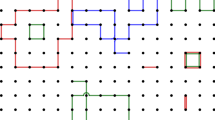Abstract
We study a one-dimensional spin (interacting particle) system, with product Bernoulli (p) stationary distribution, in which a site can flip only when its left neighbor is in state +1. Such models have been studied in physics as simple exemplars of systems exhibiting slow relaxation. In our “East” model the natural conjecture is that the relaxation time τ(p), that is 1/(spectral gap), satisfies log τ(p)∼\(\tfrac{{\log ^2 (1/p)}}{{\log 2}}\) as p↓0. We prove this up to a factor of 2. The upper bound uses the Poincaré comparison argument applied to a “wave” (long-range) comparison process, which we analyze by probabilistic techniques. Such comparison arguments go back to Holley (1984, 1985). The lower bound, which atypically is not easy, involves construction and analysis of a certain “coalescing random jumps” process.
Similar content being viewed by others
REFERENCES
J. Jäckle and S. Eisinger, A heirarchically constrained kinetic Ising model, Z. Phys. B 84:115–124 (1991).
S. Eisinger and J. Jäckle, Analytical approximations for the hierarchically constrained kinetic Ising chain, J. Statist. Phys. 73:643–670 (1993).
F. Mauch and J. Jäckle, Recursive dynamics in an asymmetrically constrained kinetic Ising model, Physica A 262:98–117 (1999).
M. A. Muñoz, A. Gabrielli, H. Inaoka, and L. Pietronero, Hierarchical model of slow constrained dynamics, Phys. Rev. E 57:4354–4360 (1998).
P. Sollich and M. R. Evans, Glassy time-scale divergence and anomalous coarsening in a kinetically constrained spin chain, Phys. Rev. Lett. 83:3238–3241 (1999).
R. A. Holley, Convergence in L 2 of stochastic Ising models: Jump processes and diffusions, in Proc. Taniguchi Symp. Stochastic Analysis, Katata and Kyoto (North-Holland, 1984), pp. 149–167
R. Holley, Rapid convergence to equilibrium in one-dimensional Ising models, Ann. Probab. 13:72–89 (1985).
P. Diaconis and L. Saloff-Coste, Comparison theorems for reversible Markov chains, Ann. Appl. Probab. 3:696–730 (1993).
G. H. Frederickson and H. C. Andersen, Kinetic Ising models of the glass transition, Phys. Rev. Lett. 53:1244–1247 (1984).
S. J. Pitts, T. Young, and H. C. Andersen, Facilitated spin models, mode coupling theory, and ergodic-nonergodic transitions, J. Chem. Phys. 113:8671–8679 (2000).
P. Diaconis and D. Stroock, Geometric bounds for eigenvalues of Markov chains, Ann. Appl. Probab. 1:36–61 (1991).
D. Randall and P. Tetali, Analyzing Glauber dynamics by comparison of Markov chains, J. Math. Phys. 41:1598–1615 (2001).
F. Martinelli, On the two-dimensional ising model in the phase coexistence region, J. Statist. Phys. 76:1179–1246 (1994).
T. M. Liggett, Interacting Particle Systems (Springer-Verlag, 1985).
P. Brémaud, Markov Chains: Gibbs Fields, Monte Carlo Simulation and Queues (Springer-Verlag, 1999).
F. R. K. Chung, P. Diaconis, and R. L. Graham, Combinatorics for the East model, Adv. in Appl. Math. 27:192–206 (2001).
J. D. Biggins, Chernoff's theorem in the branching random walk, J. Appl. Probab. 14:630–636 (1977).
M. Reed and B. Simon, Methods of Modern Mathematical Physics I. Functional Analysis (Academic Press, 1972).
Author information
Authors and Affiliations
Rights and permissions
About this article
Cite this article
Aldous, D., Diaconis, P. The Asymmetric One-Dimensional Constrained Ising Model: Rigorous Results. Journal of Statistical Physics 107, 945–975 (2002). https://doi.org/10.1023/A:1015170205728
Issue Date:
DOI: https://doi.org/10.1023/A:1015170205728




